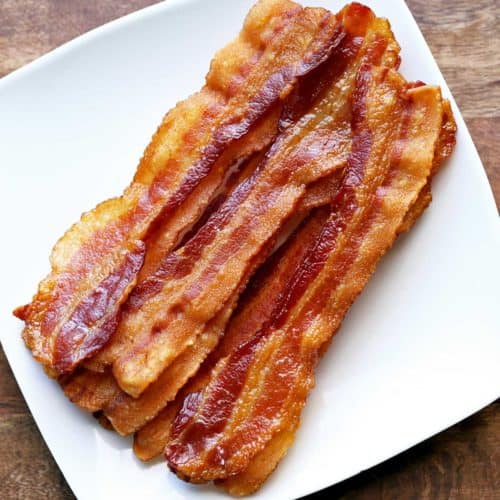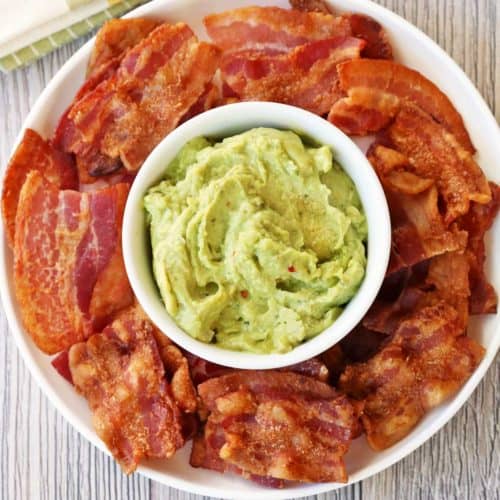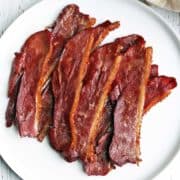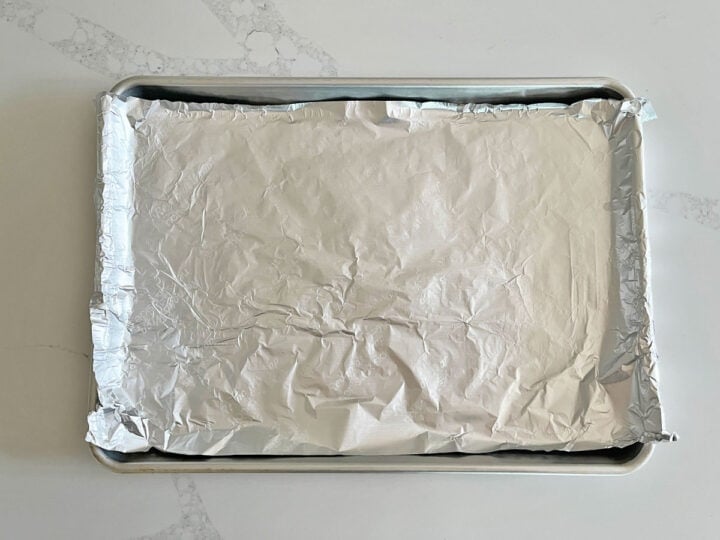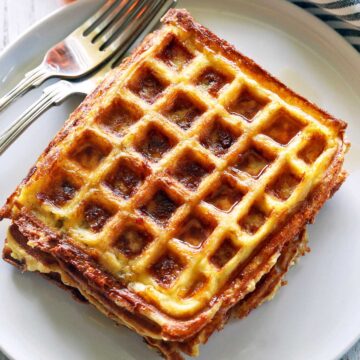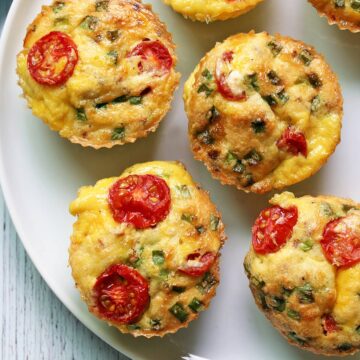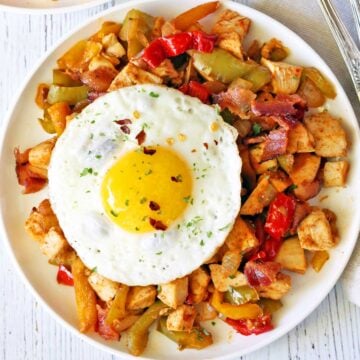Duck bacon is such a wonderful treat! Made from thinly sliced and smoked duck breast, it's thick and flavorful. While it won't crisp up the way pork bacon does, its thick chewiness is quite pleasing, and its unique flavor is a nice change from the bacon we're all used to.

While I'm not a fan of turkey bacon (I find it too lean), there are two bacon varieties that I enjoy just as much as pork - beef bacon and duck bacon. Both are deeply flavorful and make a nice change from the usual pork - although I still make microwave bacon and oven bacon often!
Ingredients

You'll only need ONE ingredient to make this recipe - a package of duck bacon. I never saw this type of bacon in the grocery store when I was living in California, but here in the DC area, I spotted this package at the local store and just had to buy it. You can also purchase it online.
Variations
This bacon is delicious just as it is, so I simply bake it in the oven without adding anything.
If you'd like to try an interesting variation, brush the slices with a very thin layer of maple syrup (real or sugar-free) and season them with freshly ground black pepper before baking them.
Instructions
There are two main methods for preparing this bacon:
Pan Frying
Arrange the slices in a large skillet. Heat the skillet over medium heat. Cook the bacon until heated through, 2-3 minutes per side. Place briefly on paper towels, then serve.
Oven Baking
Preheat the oven to 400°F and arrange the bacon slices on a foil-lined, rimmed baking sheet.

Bake the bacon for 15 minutes, then place it briefly on paper towels to absorb extra fat before serving.

Expert Tip
The USDA recommends cooking duck to 165°F, which is well done. As always, when it comes to food preparation, you should make your own informed decision. I like to cook it for about 15 minutes in the oven (meaning it will be well done) because I don't want it to be too chewy.
Recipe FAQs
It's made from thinly sliced and smoked duck breast. Since duck breast is very flavorful and relatively fatty, the result is surprisingly similar to pork bacon, although it's not as fatty.
You can't. Even if you cook it for longer, which I don't recommend because it will become dry and tough, it won't crisp up the way pork bacon does. It's simply not fatty enough (though it's definitely fattier than turkey bacon).
I actually like its chewiness. Its slices are thick and flavorful, and the slightly chewy texture is perfect, in my opinion.
No, unfortunately, you can't. For the best results, you should bake or pan-fry it.
Yes! It's REALLY good. Perhaps not as good as pork bacon because it's not as fatty, but the meat itself is actually more flavorful. I think it's WAY better than turkey bacon, making it perfect for anyone who doesn't eat pork but would like to enjoy bacon.
Serving Suggestions
The obvious way to serve this bacon is for breakfast with eggs. When I'm lucky enough to have duck eggs on hand, I make an all-duck breakfast! It's such a treat.
If you cook eggs to go with the bacon, you should definitely use the rendered fat to cook them! It's so delicious. Here's how I do it: I bake the bacon in the oven for just 10 minutes, then set the oven to "keep warm." I carefully drain the fat from the baking sheet into a skillet, then return the bacon to the warm oven and cook the eggs in the rendered fat.
You can also use this bacon to wrap various meats, like I do in this recipe for bacon-wrapped chicken breast. In fact, you can use it in most recipes that call for pork bacon.
Storing Leftovers
You can keep the leftovers in an airtight container in the fridge for 3-4 days. Briefly reheat them in the microwave, just a few seconds per slice, until they are heated through. You can also eat them cold straight out of the fridge. They're surprisingly good that way!
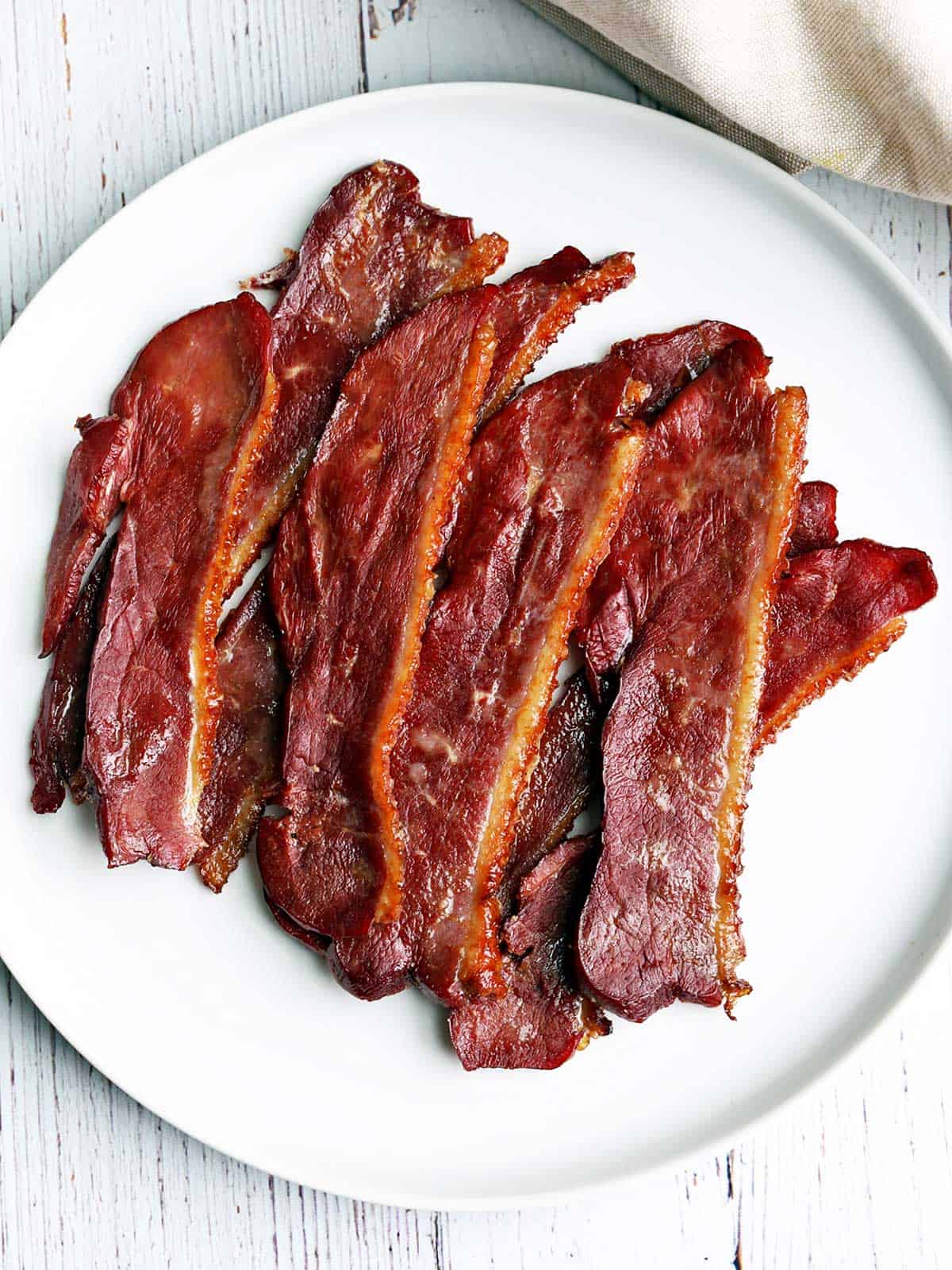
More Bacon Recipes
Eat Well, Live Well Newsletter
Sign up for weekly meal ideas, cooking tips, and real food recipes straight to your inbox! We won't send you spam. Unsubscribe at any time.
Recipe Card
Oven-Baked Duck Bacon
Video
Ingredients
- 8 ounces duck bacon
Instructions
- Preheat your oven to 400°F. Line a large, rimmed baking sheet with high-heat-resistant parchment paper or foil.
- Arrange the bacon slices in a single layer on the prepared baking sheet.
- Bake in the preheated oven until heated through, about 15 minutes.
- Transfer the bacon slices to a paper towel-lined plate for a couple of minutes to absorb the extra fat.
- Serve immediately.
Notes
- The nutrition info is based on the product's package.
- If you'd like to pan-fry the bacon, arrange the slices in a large skillet. Heat the skillet over medium heat. Cook the bacon until heated through, 2-3 minutes per side.
- The USDA says that duck should be cooked to 165°F.
- You can't make this bacon crispy. Even if you cook it for longer, which I don't recommend because it will become dry and tough, it won't crisp up the way pork bacon does. I actually like its chewiness. Its slices are thick and flavorful, and the slightly chewy texture is perfect.
- You can keep the leftovers in the fridge, in an airtight container, for 3-4 days. Briefly reheat them in the microwave, just a few seconds per slice, until they are heated through. You can also eat them cold straight out of the fridge. They're surprisingly good that way!
Nutrition per Serving
Save this Recipe!
We will also add you to our weekly newsletter. Unsubscribe anytime. See healthyrecipesblogs.com/privacy/ to learn how we use your email.
Disclaimers
Most recipes are low-carb and gluten-free, but some are not. Recommended and linked products are not guaranteed to be gluten-free. Nutrition info is approximate. Please verify it independently. The carb count excludes non-nutritive sweeteners. Please read these Terms of Use before using any of my recipes.

